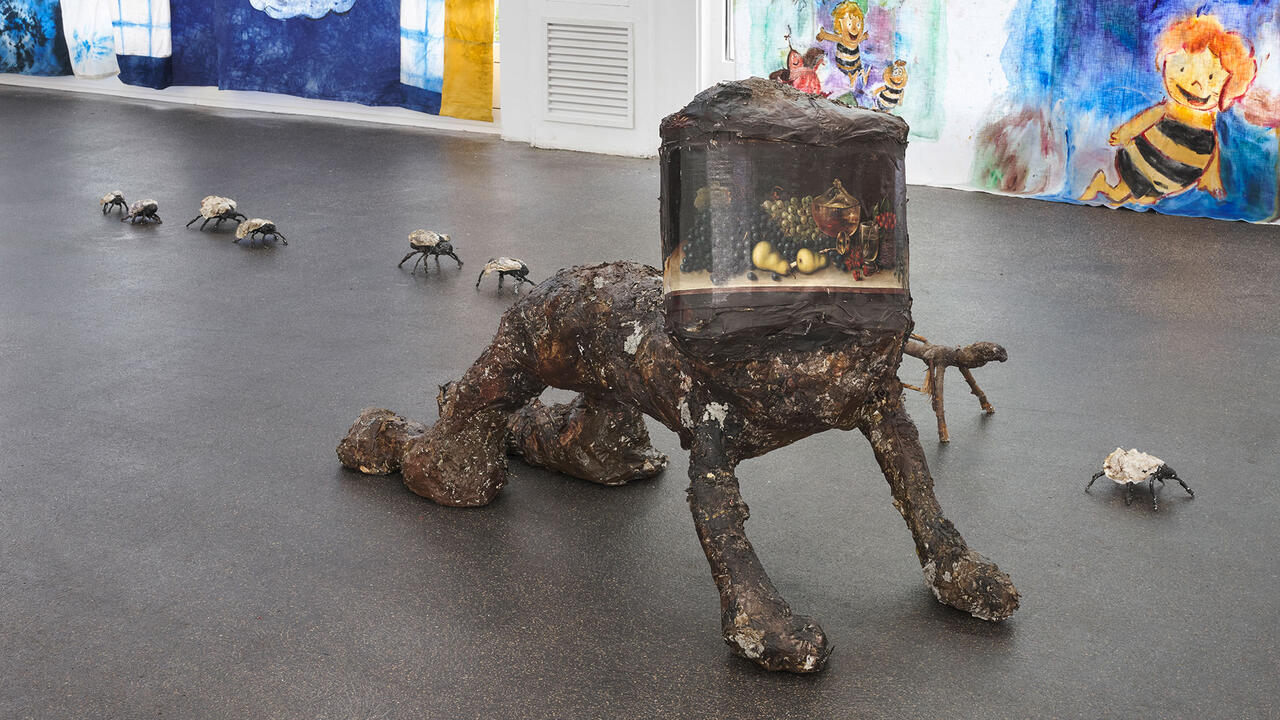Art’s Ecological Turn and the Sixth Great Extinction
Two shows, at Cologne’s Temporary Gallery and Moscow’s Garage MCA, look to art in the age of environmental collapse
Two shows, at Cologne’s Temporary Gallery and Moscow’s Garage MCA, look to art in the age of environmental collapse

‘Climate change is not an issue of the environment,’ writes the Global South collective Wretched of the Earth in the preface to a letter pleading for Extinction Rebellion to reconsider the tactics and politics of their struggle. ‘It is an issue of power, violence and greed; it is political and it requires systems change.’ Clarion calls about art’s role in tackling the climate crisis have come to sound increasingly trite as our political vocabulary attempts to catch up with the scale of the crisis. Environmental mourning, Wretched of the Earth urge, will achieve little if decoupled from the extractive politics causing its collapse.
Much of our recent ecological turn, in the arts and human sciences, has struggled to grapple with the immensity of the problem we have caused. One historical way to make sense of this is through Romantic-era theories about the sublime, which attended to our estrangement from nature and the feeling of ecstatic terror we derive from being in the presence of its fury. Some view the sublime as the central aesthetic experience of modernity, which registers the gap between the world and our ability to comprehend it. Today, this estrangement grows with our greater technological sophistication and the severity of situation.
In the context of climate destruction, representations of the ecological or technological sublime, such as the massive formats of Edward Byrtynksy or the videos of visual artist Rachel Rose, have come, for me, to seem increasingly escapist, suffering from what the cultural critic Sianne Ngai theorises as ‘stuplimity’: the sublime plus ‘whatever’. You look into the void, you look out.

Two recent exhibitions in Germany and Russia took a different tack. The first was held in Cologne this summer: a modest group show held at the not-for-profit Temporary Gallery, ‘Heart of an Old Crocodile Exploding Over a Small Town.’ The second, at Moscow’s Garage Museum of Contemporary Art, ‘The Coming World: Ecology as the New Politics 2030–2100’, which runs until December. Both shows chose not to span out but to drive in to consider our current predicament, focussing on the creaturely, the subterranean and the weird, to think through life within and beyond the anthropocene.
In Cologne, the best works included a series of oils by young Belgian painter Bram Demunter, whose carnivalesque delight in totemic motifs and scenes of ritual healing envisioned new ways of cohabitation. The hunched bodies and wizened faces of his subjects are shown in stilled embraces, looking past one another, amid verdant scenes on the verge of malevolence. Demunter deals explicitly with racial politics, showing faces of many shades, some in headscarves, others with beards. These paintings imagine forms of conviviality and community that can emerge in times of crisis, while avoiding the pitfalls of utopianism. Above all redolent of the freakish gardens of Hieronymous Bosch, they commute the devotional energies of Byzantine Christian painting into the vibrant greens of a renewed closeness to the earth, without implying localism or prelapsarian fantasy. In one painting, a man’s head is shrunken, unfinished, and disturbingly pinkish-violet. A clan of eyeless dogs guards an inner islet.
A series of yellow suns with phallic noses and a giant grinning lizard by Bärbel Lange touched on something fabular and ancient. Scent artist Laurent David Garnier, at the invitation of Janek Simon, distilled the essence of dynamite, suffusing the gallery space with an apocalyptic odour. This resonated with one of Demunter’s oils, Botanical garden (2018), in which persons naked and clothed huddle amid a network of fire circles threatening to engulf them, while scattered headless dogs and pink magnolias avert its possible horror. Probably the modern mind cannot get all the way back to what writer John Berger called ‘magical functions, sometimes oracular, sometimes sacrificial’ – but still we can try.

‘The Coming World’, curated by Snejana Krasteva and Ekaterina Lazareva, also went after tactility. In Russia, where only 43% of people see global warming as a major threat, curating such a show meant something different from Germany, where 77% of people are convinced of the gravity of the crisis. Just as Vladimir Putin formally signed onto the Paris Climate Accords – four years late and just before the US announced its withdrawal – Garage’s grand smorgasbord of a show sat somewhere between contemporary art display and consciousness-raising endeavour.
Curators enlisted Critical Art Ensemble as eco-consultants, implementing some of their measures by, for instance, calculating the show’s carbon footprint and minimising transportation of artworks. It still seems worth nothing, in an art world that swills with oil money, that the gallery, founded by Roman Abramovich and his ex-wife Dasha Zhukova, has two-thirds of its $13–$15 million annual budget underwritten by their wealth. Abramovich, early in his tenure on the Russian media-politico scene, made a large chunk of his billions through the sell-off of Russian oil company Sibneft.
Where the show in Cologne used Donna Haraway’s ‘cyborgs’ and ‘companion animals’ as a theoretical backbone, the show in Moscow drew on futurist Arthur C. Clarke, setting a mordant tone for its myriad thought experiments: ‘The one fact about the future of which we can be certain is that it will be utterly fantastic’; Clarke’s 1962 proclamation met us at the entrance to a network of futuristic pods. Two sculptures from Patricia Piccinini, Litter and The Comforter (2010), take hyperrealism to an unhomely extreme. Pinkish simian babies with hairy backs and broad, elfin noses nestle together asleep; a girl, ailed by hypertrichosis, cradles a large, hand-like, faceless, hairless lump of flesh.

In the main hall, Mella Jaarsma’s Dogwalk (2016) appeals to a kitschy talismanic anthropomorphism through animal-hide uniforms connected by a web of leashes. For Ultrafuturo’s graffiti mural The Mirror of Faith (2018), the duo (Boryana Rossa and Oleg Mavromatti) centres on the story of sceptical apostle Doubting Thomas to pastiche the essentialism implicit in the 2004 announcement of a ‘God gene’: an innate predisposition to religious spirituality. Transfecting DNA from the alleged ‘God’ gene into a yeast culture, they fashioned a glass model of a yeast molecule lit up violet as a would-be-relic for visitors’ genuflection, replete with small finger sockets just out of reach of the hieratic object.
Many works erred on the side of spectacle: an open cage once inhabited by a live wolf and the artist wearing VR goggles streams a virtual ‘natural’ world, a flatly ironic comment on the solipsism of contemporary existence: giant cockroaches scale the side of a suspended room. In an immersive chamber facing a tank of whirling jellyfish – a life-form projected to survive the great devastation – we answer the command of a disembodied voice asking us to point at the person among us who looks like they will die first.
As in Cologne, the most stimulating artworks were often, paradoxically, seemingly the most traditional. A series of photographs by Allan Sekula, ‘Black Tide/Marea Negra’ (2002-3), records the aftermath of the 2002 Prestige oil spill off the coast of Galicia. In a mood of ecological melancholy, glossy reds, greys and blues focus the faces of those affected, the look of the waters, to register the unavoidable elegy of what they depict.
Quoting critic T.J. Demos, Garage asserted that ‘just as nature can no longer be understood as a pristine and discrete realm apart from human activity, art’s autonomy is all the more untenable when faced with ecological catastrophe.’ Artistic responses to the current moment are inevitable and many are powerful works of imagination; but we should, perhaps, be wary of the delusion that art has either the time or the means to ‘inspire viewers to action’ as the sixth mass extinction sets in. Such easy talk makes me suspicious. In the words of the young Swede: entire ecosystems are collapsing. What we need now is better politics, not more art.
‘The Coming World: Ecology as the New Politics 2030—2100’ runs at Garage MCA, Moscow until 1 December 2019.
Main Image: ‘Heart Of An Old Crocodile Exploding Over A Small Town’, 2019, installation view, Temporary Gallery, Cologne; photograph: Simon Vogel





















